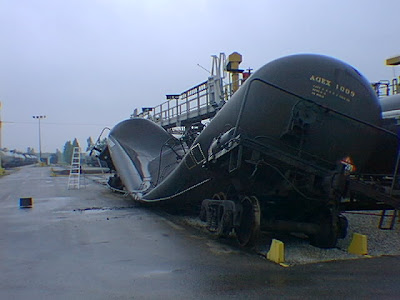Thursday, April 10, 2008
Display problem ? Click HERE
Vaccum hazard is potentially a hazard and damaging factor to many pressure vessel. Vacuum should be addressed and extra caution to be taken during design, construction, operation and maintenance to avoid catastrophic failure. Following are four (4) steps approach to combat vacuum hazard.
Avoid it
This is the first principle to be adopted in any design and operation. System shall be designed and operating procedures shall be implemented to avoid the occurrence of vacuum condition in a vessel.
Whenever there is a potential of vacuum can be created, an automatic control system may be implemented to prevent it from occur. Some typical control system could be
Whenever the control system as mentioned in earlier section can not prevent it to happen, provide a high level shutdown system to stop continuous further creation of vacuum. Typically a highly reliable low-low pressure trip is provided to stop a external mechanical driver to continue operate e.g. stop reciprocating pump which is drawing water from a vessel.
Protect it- Vessel to be kept pressurized during cooling until the vessel and it contents cooled to ambient temperature.
- Vessel to be purged with inert gas prior to any cooling cycle
Whenever there is a potential of vacuum can be created, an automatic control system may be implemented to prevent it from occur. Some typical control system could be
- Inert gas blanketing system to maintain positive pressure in the vessel
- Continuous purging system in the flare header
- Application of insulation layer to avoid sudden heat loss to ambient
Whenever the control system as mentioned in earlier section can not prevent it to happen, provide a high level shutdown system to stop continuous further creation of vacuum. Typically a highly reliable low-low pressure trip is provided to stop a external mechanical driver to continue operate e.g. stop reciprocating pump which is drawing water from a vessel.
This is the last resource but shall be implemented whenever a risk of vacuum is identified and present.The main concept is provide a system or device to sustain or break the vacuum whenever it occurred.
Related Post
- Design the system for FULL VACUUM
Full vacuum (FV) — a condition where the internal absolute pressure is 0 psi (0 KPa) and the external absolute pressure on the vessel is 15 psi (100 KPa).
- Provide Pressure-Vacuum-Relief-Valve (PVRV) to break vacuum in case it occurred.
- May consider to provide liquid seal as vacuum breaker
Related Post
- Vacuum Hazard - Another Catastrophic Factor...
- Parallel Valve Technology Increase Safety & Reduce Nuisance Trips
- Dust Explosion Basic & Protection
- Why not bury flare pipe header ?
- Extra Caution When Eliminating Overpressure by Fire Attacks
- Blast rocks Texas oil refinery
- Petrol Kiosk - Some Thought and Advices...
- Design fault in Hydrogen Attack of Residue Hydrodesulfurrization

1 Comments:
how did it happen?
Post a Comment
Let us know your opinion !!! You can use some HTML tags, such as <b>, <i>, <a>
Subscribe to Post Comments [Atom]
Home:
<< Home